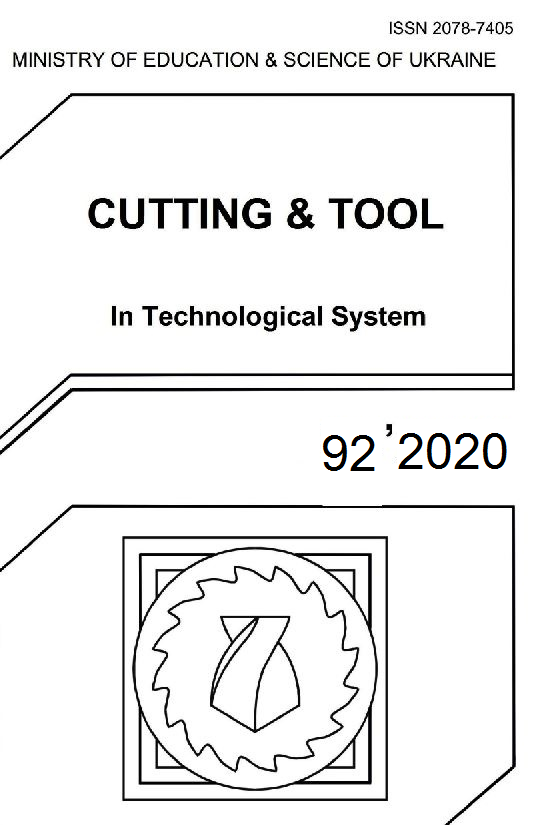MECHANO-PHYSICO-CHEMICAL MODELING OF THE PROCESS OF DESTRUCTION OF THE PART SURFACE IN A FREE ABRASIVE MEDIUM
DOI:
https://doi.org/10.20998/2078-7405.2020.92.08Keywords:
abrasive granules, the processed surface, cutting, plastic deformation, friction, traces of processing, destruction of the material.Abstract
The analysis of the phenomena in the zone of collision of the working medium granules with the parts surface is presented. It is noted that the abrasive granules of are embedded in the processed part surface by the grains protruding from the bundle. It is indicated that the contact of the abrasive granule with the part surface carried out within small size areas, determined by the strength of the collision, the number and state of the active grains, their level of fixation, dimensions and physical and mechanical properties of the part material. The behavior of a single granule moving relative to the processed part is considered. The main types of abrasive grain action on the processed surface are highlighted, that is, cutting, plastic deformation and friction, it is noted that over time, abrasive grain can initially perform only friction, then plastic deformation, then cutting. It is established that such an alternation of the abrasive grains work is associated with the nature of the movement of the granules on the surface of the processed part. High-speed video recording of single processing traces showed that granules leave on contact surfaces the processing traces that are difficult to outline, differ in depth and location on the surface. It was determined that the track depth changes in the direction of granule movement and is calculated by the speed of its movement, as well as by the strength and frequency of penetration into the material of the part during contact. Electron microscopic studies show the presence of adhesive spots and oxide films at the contact sites. This confirms that in the process under consideration, as well as during grinding, polishing, and finishing, continuous exposure of juvenile surfaces occurs. It was established that the interaction of active juvenile surfaces and plastically deformed volumes of metal with aggressive components of the working medium leads to the formation of secondary weakened structures on their surface, the layer thickness of which is 0.05 ... 0.08 μm. The parameters of the processing mode that determine the nature of the physical and mechanical processes of interaction of the single granule and the processed part are established. The differences of the vibrating abrasive treatment method from the known finishing methods are considered. The mechanism of destruction of the part material is shown and the stages of mechanical and physicochemical modeling of the process of vibrating abrasive treatment are presented.References
Babichev A.P. Osnovyi vibratsionnoy tehnologii / A.P. Babichev, I.A. Babichev. – Rostov n/D: Izdatelskiy tsentr DGTU, 2008. – 694 p.
Kartashov I.N. Obrabotka detaley svobodnyimi abrazivami v vibriruyuschih rezervuarah / I.N. Kartashov, M.E. Shainskiy, V.A. Vlasov. – Kyiv: Vischa shkola, 1975. – 188 p.
Politov I.V. Vibratsionnaya obrabotka detaley mashin i priborov / I.V. Politov, M.A. Kuznetsov. – L.: Mashinostroenie, 1965.
Rebinder P.A. Vliyanie aktivnyih smazochno-ohlazhdayuschih zhidkostey na kachestvo poverhnosti pri obrabotke metallov rezaniem i davleniem. – Moscow: Izd-vo AN SSSR, 1946. – 432 p.
Babichev A.P. Primenenie vibratsionnyih tehnologiy na operatsiyah otdelochno-zachistnoy obrabotki detaley (ochistka, moyka, udalenie obloya i zausentsev, obrabotka kromok) / A.P. Babichev, P.D. Motrenko, L.K. Gillespi. Rostou-na-Donu: DGTU. – 2010. – 289 p.
Kostetskiy B.I. Trenie, smazka i iznos v mashinah / B.I. Kostetskiy. – Kyiv, 1970.
Babichev A.P. Vibratsionnyie stanki dlya obrabotki detaley / A.P. Babichev, V.B. Trunin, Yu.M. Samodumskiy, V.P. Ustinov. – Moscow: Mashinostroenie, 1984. – 168 p.
Downloads
Published
Issue
Section
License
Copyright Notice
Authors who publish with this Collection agree to the following terms:
1. Authors retain copyright and grant the Collection right of first publication with the work simultaneously licensed under a Creative Commons Attribution License that allows others to share the work with an acknowledgement of the work's authorship and initial publication in this Collection.
2. Authors are able to enter into separate, additional contractual arrangements for the non-exclusive distribution of the Collection's published version of the work (e.g., post it to an institutional repository or publish it in a book), with an acknowledgement of its initial publication in this Collection.
3. Authors are permitted and encouraged to post their work online (e.g., in institutional repositories or on their website) prior to and during the submission process, as it can lead to productive exchanges, as well as earlier and greater citation of published work.

